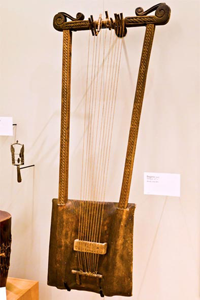History and origin of the Jawari 3.
The Mesopotamian lutes travelled to Syria and south to Egypt and Africa where they became extremely popular. Please read about the way the Egyptian lute bridge design compares with the modern Indian bin. 3500 year old Egyptian Lute design compares to the Bin .
Still today, we find the very auspicious Begena from Ethiopia. (See here a begena). Apparently this Ethiopian box-lyre is an old instrument from Ethiopia and Sudan, most probably related to lyres from the New Kingdom period of ancient Egypt, and undoubtedly inspired by the Sumerian lute. The begena has a wide flat wooden or bone bridge with a little piece of leather placed between the gut string and the bridge, to create a buzzing sound. Although using other materials, it has exactly the same principles as the Indian tanpura. Legend has it that the begena was the instrument played by King David of the Israelites. Remarkably, there are lyres known as tanbura that originated in upper Egypt and Sudan.

I endeavour to suggest that because of the geographical location of Mesopotamia the lyre must have also found its way into Ancient India. There were many peoples travelling from Europe, Middle East and North Africa and passed through Mesopotamia. It was also about that time in history that many peoples coming from the West (and North) were settling down in the Indus valley, where the great civilisations of Mohenjodaro and Harappa emerged. There is a strong chance that the musical instruments traveled with them. However, according to B.C.Deva, it was doubtful that lyres existed in India at all, except for one vague lyre type instrument on one of the Indus valley inscriptions.
